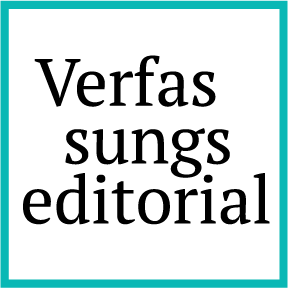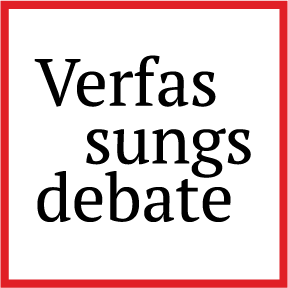The Claim of Hybrid Attacks
Balancing State Sovereignty and Migrants’ Rights at the European Court of Human Rights
On 12 February 2025, the Grand Chamber of the European Court of Human Rights heard three cases concerning asylum seekers who were repeatedly pushed back at the EU’s external border with Belarus, often in dire humanitarian conditions. The cases attracted significant attention: around 400 people attended the hearings in Strasbourg, and a total of 48 third-party interventions were filed, including one submitted by a group of 22 academics, among them the authors of this blog post. At the centre of the hearing was the question of whether and how the geopolitical context can affect the level of human rights protection. Specifically, Poland, Latvia and Lithuania relied on the fact that beginning in 2021, Belarus actively encouraged and facilitated the irregular entry of migrants from third countries to put pressure on the EU. They reacted with broad-scale pushbacks, declaring Belarus’s instrumentalisation practice a form of “hybrid war”.
In R.A. and Others v. Poland, 32 Afghan nationals fleeing the Taliban found themselves trapped in a makeshift camp at the Belarusian-Polish border. Polish authorities allegedly ignored their asylum applications and forcibly returned them to Belarus. Similarly, in H.M.M. and Others v. Latvia, 26 Iraqi Kurds seeking asylum in Latvia were subjected to multiple pushbacks between Latvian and Belarusian authorities. They claim to have been detained in a tent without access to basic necessities, subjected to physical abuse, and ultimately pressured into agreeing to return to Iraq. In C.O.C.G. and Others v. Lithuania, four Cuban nationals faced repeated pushbacks from Lithuanian authorities to remote locations and “push-forwards” from Belarusian authorities after attempting to enter Lithuania to seek asylum, where they were finally granted international protection.
Framing migrants as “hybrid threats”
A central element of the governments’ argument was the framing of migration as a “hybrid war” orchestrated by Belarus (and Russia). The Polish government claimed that the latter intended to “permanently destabilise the borderline” and “undermine regional security”. The Lithuanian representative went even further, asserting that Belarus was “using the Convention as a weapon against our democracy”. All three governments urged the Court to consider this “extraordinary context” when assessing their treatment of irregularly entering migrants. In support of such an approach, they cited Ždanoka v. Latvia (No. 2), where the Court recognised that it “does not operate in a vacuum” (para. 55) and accepted the barring of a candidate for parliamentary elections in light of constitutional concerns.
The intervening Finnish government attempted to ground such a balancing approach in a context-and-purpose-oriented treaty interpretation. Reframing human rights through the lens of geopolitical stability, it argued that safeguarding European security had been a foundational aim when the Convention was drafted in the aftermath of World War II. The intervening Commissioner for Human Rights of the Council of Europe (CoE), Michael O’Flaherty, warned that this line of argumentation signals a broader trend towards “human rights exceptionalism”, where states carve out convenient exceptions to absolute protections. As he pointed out, Art. 3 ECHR leaves no room for such balancing: the prohibition of inhuman or degrading treatment is absolute, irrespective of the political context (for example Saadi v. Italy, para. 127; Hirsi Jamaa and Others v. Italy, para. 122).
Naomi Hart, representing the applicants in H.M.M., underlined that such an approach risks conflating individuals seeking protection with state actors orchestrating geopolitical destabilisation. If the states wanted to respond to so-called “hybrid attacks” by Belarus, they should apply countermeasures under general international law against Belarus instead of denying individual protection to migrants and refugees.
Interrelation with EU Law
While the Court only interprets the ECHR, the judges were also interested in the recent legislative developments on the EU level addressing “hybrid threats”. Thus, exceptions from the regular border procedure in situations of “instrumentalisation” were recently introduced through the 2024 Crisis Regulation and the revised Schengen Borders Code (SBC), which will enter into force in the summer of 2026. Emergency measures are already possible under Art. 78(3) TFEU. These instruments permit far-reaching deviations from well-established legal standards but explicitly reaffirm non-refoulement. While all three respondent states adopted national states of emergency (see here, here and here), providing for various derogations from the rights of asylum seekers, civil society and journalists, the Council did not adopt the Commission’s proposal for provisional measures from December 2021 under Art. 78(3) TFEU to back the emergency approach of the three governments. The French Judge Guyomar was particularly interested in national declarations of a state of emergency in relation to Art. 72 TFEU, which expressly leaves the “maintenance of law and order and the safeguarding of internal security” up to the member states. He also asked how the alleged pushbacks may comply with the reasoning of a judgment by the European Court of Justice which decided that Lithuania’s state of emergency did not justify depriving applicants of international protection and access to the procedure. The representatives of Lithuania and Poland responded that the facts of the cases at hand were different. All three state representatives emphasised the importance of the member states’ resilience concerning external border protection, claiming that the Schengen area depends on that protection to guarantee security and territorial integrity. Lithuanian representative advanced that, in light of the reform of the Common European Asylum System (CEAS) and a recent communication by the EU Commission, there was an “emerging consensus” that EU law may allow restrictions on asylum seekers’ rights in cases of “instrumentalisation of migrants”.
Transferral of N.D. and N.T. v. Spain
The central issue of the hearing was whether the exception clause of N.D. and N.T. v. Spain should be applied to the present cases. In that ruling, the Grand Chamber had rejected a violation of Art. 4 Prot. 4 ECHR, deeming the collective expulsion without an individual assessment of protection claims a consequence of the applicants’ own “culpable conduct” (para. 208) since they had attempted to enter Spain en masse by storming the border fence instead of approaching official border crossing points. The governments sought to draw a direct parallel, arguing that the applicants had deliberately circumvented official border crossings and had failed to make use of available legal pathways, such as humanitarian visas. Lithuania, for instance, insisted that the applicants “did not genuinely seek asylum” but instead sought to exploit the situation to reach their preferred destination (Spain), demonstrating a “disregard for legal order”. At the same time, the governments called upon the Court to consider the geopolitical pressure when assessing the (in)accessibility of legal entry points and Belarus’ part in that (with reference to N.D. and N.T. v. Spain para. 218).
Leaving aside more fundamental criticism (see, among others, here and here), the applicants and Commissioner pointed out that the factual circumstances of N.D. and N.T. bear little resemblance to small groups of peaceful individuals who were either stranded for weeks in a militarised border zone (as in R.A. and Others v. Poland) or pushed back and forth between the authorities and exposed to physical abuse by border guards (as in H.M.M. and Others v. Latvia, and C.O.C.G. and Others v. Lithuania). This is a far cry from “situations in which the conduct of persons who cross a land border in an unauthorised manner, deliberately take advantage of their large numbers and use force, is such as to create a clearly disruptive situation which is difficult to control and endangers public safety” (N.D. and N.T. v. Spain para. 201). The Court’s finding in N.D. and N.T. v. Spain also hinged on the fact that Spain had provided “genuine and effective access to means of legal entry” (para. 201). Therefore, several judges asked about the actual possibilities of legal entry. The affirmative answers of the governments revealed that the border crossing points were not necessarily accessible on foot. The applicants pointed to national emergency regulations that limited entry from Belarusian territory and highlighted that their inability to use legal pathways was not a matter of choice but the direct result of practical obstacles imposed by the state. In C.O.C.G and Others v. Lithuania., for example, border guards reportedly transported the applicants to remote locations deep in the forest on Belarusian territory rather than to border crossing points. The Commissioner warned against an overly expansive interpretation of N.D. and N.T. v. Spain, arguing that irregular entry alone should not be equated with culpable conduct. He also pointed to a contradiction in the governments’ argumentation, which portrayed the applicants as mere instruments of a “hybrid attack” while simultaneously blaming them for the irregularity of their border crossings.
The relationship between Art. 3 ECHR and Art. 4 Prot. 4 ECHR
Given that N.D. and N.T. v. Spain only concerned the prohibition of collective expulsion under Art. 4 Prot. 4 ECHR, all state parties asked the Court to clarify how this guarantee relates to the prohibition of refoulement under Art. 3 ECHR. Under Art. 3 ECHR, states have negative and positive obligations: they must not expel individuals if there are substantial grounds to believe they face a risk of torture or inhuman or degrading treatment, and they must carry out a rigorous assessment to determine whether such a risk exists (Soering v. UK, paras. 90-91; Ilias and Ahmed v. Hungary, paras. 129-131). This prohibition is absolute, permitting no exceptions. Naomi Hart emphasised that these negative and positive obligations are “intimately intertwined”. If a state fails to conduct a proper risk assessment, this failure might result in the removal of a person to a country where they face serious harm. This, in turn, would violate the state’s negative obligation not to remove individuals to a state where they face a real risk. The performance of the negative obligation thus depends on the strict performance of the positive obligation, rendering collective expulsion without an individual assessment unacceptable (see also the concurring opinion of Judge Albuquerque in Hirsi Jamaa and Others v. Italy). This represents a significant overlap with Art. 4 Prot. 4 ECHR”, which arguably renders the latter absolute too (see also the Toolkit to Protocol 4 on the CoE website).
The Court already provided some guidance in N.D. and N.T. v. Spain, where it expressly stated that the exceptions to Art. 4 Prot. 4 ECHR do not affect the obligation of the contracting states to conduct their border control “in a manner which complies with the Convention guarantees, and in particular with the obligation of non-refoulement” (para. 232). Contrary to the governments’ submissions, the absolute character of this prohibition does not allow for security-based exceptions (see Hirsi Jamaa, para. 122). Despite repeated questions from the bench, neither the state representatives nor the Finnish intervener were able to provide the judges with a clear account of how this absolute prohibition could be reconciled with the balancing approach they requested.
What’s at stake
Ultimately, the governments argued that the threat to national security from Belarus should grant them a wide margin of appreciation in their treatment of migrants, even in relation to non-refoulement. In asking the Court to find their pushbacks to be in accordance with Art. 4 Prot. 4 ECHR and Art. 3 ECHR, they urged it to establish an unwritten exception. This also raises questions about the rule of law from which states seem willing to depart in cross-border situations, especially since no derogation under Art. 15 ECHR was declared. While it is true that the Court has the very difficult task of manoeuvring between state sovereignty and human rights, national security should not become a blank cheque for governments to restrict rights. The crisis rhetoric bears the risk of opening Pandora’s box and permitting states to substantially eviscerate the Convention’s core guarantees. The answer to threats by Belarus cannot be the objectification of migrants and denial of their rights but must address the threatening state. One may hope that the Court will follow the Commissioner’s call to turn away from the much-criticised path of poking holes in the Convention’s protection framework for migrants and instead “provide clear guidance on ensuring that non-refoulement obligations are honoured without exception”.




Very interesting read. I agree with the notion that allowing security exceptions to absolute protections would be a ‘Pandora’s box’ as the authors put it – and that is most certainly a slippery slope we don’t want to trust our governments with. But the question remains of how to legally address Russian-backed hybrid threats against European security. Especially given the gap in international law with regards to hybrid threats. The law of state responsibility requires attribution. Is it feasible to attribute the actions of the applicants to Belarus? Is that in fact the appropriate lens to look through? Many questions, very few answers (yet).
Thank you to the authors for their valuable insights.